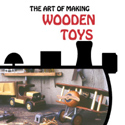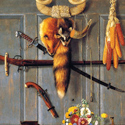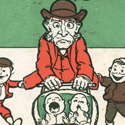After that I visited a number of smaller leather shops, and saw a lot of really interesting old sewing machines (some of them hand-cranked, some pneumatic-powered) beyond the typical Singer 29ks and Tippman hand stitchers:
The Colonial Homestead, Millersburg, Ohio (and other shops in Amish Country)
Posted by jdg | 11:39 AMAfter that I visited a number of smaller leather shops, and saw a lot of really interesting old sewing machines (some of them hand-cranked, some pneumatic-powered) beyond the typical Singer 29ks and Tippman hand stitchers:
"At a party filled with the denizens of the mainstream of Human Progress, I was once introduced to the smiling ensemble with a good deal of gratifying enthusiasm as 'the fellow who makes toys.'
There was a moment's hesitation while the smiles were quietly reinforced, and then one tanned, good-natured smile asked with much interest, 'That's nice, but why?'
Did I make a lot of money at it? Was it for political favor? Did it attract the ladies, being the fellow who makes toys?
Why, in fact, should a grown, sane---for the sake of argument---semi-responsible adult, with no special fascination for the woodshop and no particular promise of remuneration, waste his time making toys when there are shops full of the same on nearly every street corner?
Why make toys at a time when, as never before, toymaking has become such a colossal industry---when at this very minute toys are being made that use almost every shape and theme known to man?
. . .
Toymaking, as everyone knows, is a major industry and, as such, must obey the rules of survival for any other profit-making giant. The goal is to appeal at the time of potential sale, and all else is incidental. To do this, many concerns must slavishly follow adult consumer trends, pander to short-term interests, exploit a childish fascination with the grotesque, and back it all up with a fundamental faith that man's desire to dominate will sell forever---especially to kids.
Because a toy, to the merchandiser, is not a necessity or a functional item, it must follow strict criteria to insure consumer acceptance. The commercial toy must be as gaudy and as cheaply made as possible, with a consequent loss of durability, safety, and lasting value. The toy must knock down to handy shipping size, must sell at a fixed multiple of its worth, must fill proper display requirements, and must attract a suitably significant slice of the populace. It must be so intricate to manufacture that no other concern will risk the cost of tooling to steal the idea once the first concern has the jump on the marketing promotion.
Thus the boom in twentieth-century toymaking, complete with all the technological resources of computerized research, has pushed and stretched the meaning of the word 'toy' to cover everything from pliable sex-appeal dolls to fully functional miniatures of that character-building, time-honored sporting tradition of our culture---the jalopy derby.
As a result of the machinations of big business competition, only the hardiest marketing risk can survive. And so it has come to pass that in spite of the toy boom, or perhaps because of it, never has so few true toys been offered."
from The Art of Making Wooden Toys (1975) by Peter Stevenson, 1941-2012
One of my favorite books. Stevenson Projects lives on here.
Grandma must have been a pretty cool lady, we all agreed.
My favorite dads from anti-suffrage cartoons and postcards, i.e. I AM YOUR TURN-OF-THE-CENTURY NIGHTMARE
Posted by jdg | 1:27 PMAs a man who has been the primary caregiver to my children for over six years (I don't like to say stay-at-home dad, but, well: yeah), I have spent years collecting propaganda images of fathers burdened by their children created during the women's suffrage movement. Here we see one of the "worst possible outcomes" of giving women equality, and I love the idea of my lifestyle horrifying an entire generation of selfish, boneheaded jerks.

Okay, that one is officially my new facebook profile picture. Note the bucket.
Hell yes:
Even the great Honoré Damier got in on the action:
What I love about this propaganda is the idea that these men are supposed to be emasculated or feminized by attending to their children (which I may joke about sometimes, but hardly believe). A hundred years after these images were published, when I was interviewed by that New York Times reporter last summer, the conversation turned (as it always does) to the "but don't you feel emasculated" BS, and I got pretty riled up and started talking about how I get to do so many more "manly" things now than I ever did when I was working in an office. I really think that's true. Few people ever talk about the (rightful) emasculation of the American office environment, in the sense that as more and more women get high-paying, high-power jobs in corporate America, finance, medicine, law, etc., there is no longer anything really all that masculine about sitting around on your ass in an office all day staring at a computer screen and yapping into a speaker phone. Why, you can't even sexually harass a secretary like they do on Mad Men without putting your corporation at a risk for a huge financial hit! In fact, women have proven to be so great and effective working in traditional male office jobs that it seems like maybe those jobs were never all that "manly" to begin with. Whatever I am now, I take care of my kids' every need and do the laundry AND I spend most of my days in the fresh air out of doors. I've learned to work wood and leather, fix bikes and build wagons and toys, grow food for our table, and even make a fair bit of money writing and taking photos. I don't know if that makes me any more or less masculine than if I'd stayed in my career, but it sure as hell makes me feel more human than when I was spending 60 hours a week parked in my Aeron chair 28-stories above an outrageously expensive city I was too busy to really experience. So, as the living personification of all those turn-of-the-century fears, I wish I could whisper in the artists' ears: Chill, y'all. It's actually not that bad.
(I would, however, also verify that mustache and beard-pulling is definitely an occupational hazard)





















































